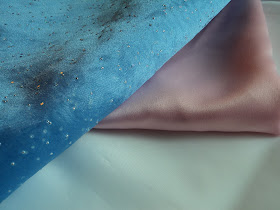Now that we have our pattern, it's time to get on with creating the dress! Oh, wait, the skirt, got to show you how to cut that, right?
First off, a look at the lovely fabrics we'll be using. And enjoy the loveliness, because that Organza is terribly difficult to work with and I highly doubt I'll be using it again until I get my serger. (What's the difference between our favorite sheer fabrics, Organza and Chiffon? Check out here: http://www.ehow.com/about_6623939_fabric_-difference-between-chiffon-organza.html)
Cutting out a skirt is pretty straightforwards. It's basically length and width measurements, cut on a triangular shape.
Make sure that the diagonal line is the same length as the center of the panel! Otherwise the skirt will come out uneaven!
I usually cut out half the skirt, then rotate the piece to serve as a pattern for the other half. This allows me to get maximum use out of the fabric.
A look at the master-book, wherein I keep all information pertaining to each dress and each version I create of the dress for individual customers.
Organza is a nasty fabric when it comes to fraying, so it's absolutely necessary to finish the inside seams. I choose to employ a french seam here.
Remember how I said this fabric was hard to work with? The jewels were gorgeous, but they made for an uneaven seam as shown above. Not super-noticeable, but enough to frustrate my sense of perfection.
The skirt is shown and I decide to demonstrate how lovely it looks flying in the breeze...
Sleeves and skirt!
One thing I often like to do, when I get to a certain level of completion, is lay out all the pieces and get a good idea for how the finished dress will look. Here I'm pretty happy - except for those pesky organza sleeves.
A narrow hem on a diagonal organza seam refuses to lie flat. I ironed and ironed and finally gave up. It was about midnight and I kept mulling over the problem in bed, until finally I had to get up and do some research on how to hem the sleeves without access to a serger.
In the end I utilized a method that involved folding the fabric over, sewing a zigzag edge twice, and trimming the excess fabric.
Believe it or not, it made for a pretty nice hem!
Original sleeves on the left, new sleeves on the right. See how much nicer they look?
Keep reading over at Part III!















No comments:
Post a Comment
Welcome to the discussion! Please note that due to chronic illness, I am no longer taking commissions of any kind.
Thank you for being polite and profanity free :)